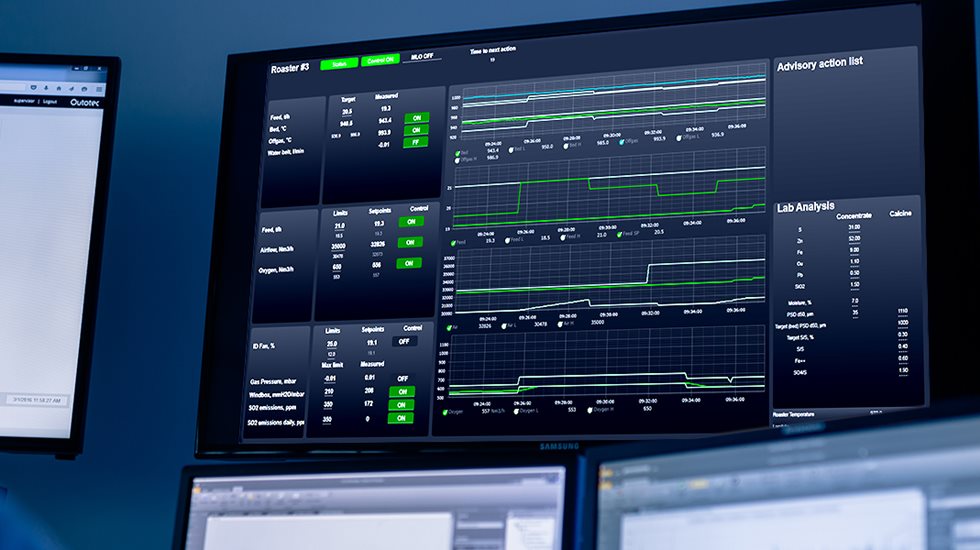When and how was the idea of the Calciner Optimizer born?
In the past few years, we noticed that some of our customers’ plants were not operating at the optimal level, many of them showed operational fluctuations on a day-to-day basis. As an example, we often observe that the specific energy consumption varies from one day to the next. Given that the feed material is the same as well as the plant setup is unchanged, such fluctuations are often found in the operations of the complex process plants. Thus, we identified a need for operational support, and, consequently, for developing our digital solution to help the customers. Plus, we already had the Roaster Optimizer, a proven digital solution for the fluidized bed processes. While looking at the similarities between the processes, we found that many aspects could be transferred from roasting to calcination. And about a year ago, the final idea of the Calciner Optimizer was born.
How many people were involved in the R&D work?
In the R&D team, we have experts involved in the process and equipment modelling as well as experts for advanced process control. Altogether, there were three people from our R&D team working on the Calciner Optimizer.
How does the Optimizer benefit our customers?
In alumina refineries, one of the main cost drivers is the fuel consumption in a calcination plant. Thus, energy reduction is the main target for most of the operating customers. Our solution helps them to improve the energy efficiency of the plant by stabilizing the process. Less temperature fluctuations, for example, will also reduce equipment stress. Through stabilizing the plant, less shutdowns will occur. As a result, plant availability is expected to improve in the long term. Through process know-how, the plant can be run in a very high throughput operational window. Plus, we continuously try to improve our solution’s plant monitoring functionalities to detect issues earlier and to allow better planning of countermeasures.
What differentiates our Calciner Optimizer from its competitive alternatives?
With the Outotec background of several decades in plant and process design and engineering, there is a lot of process know-how available. We pay strong attention to our customers’ needs and challenges. With our digital solution, we attempt to precisely work on the most relevant points by making our know-how available in the daily operation. We also have a close cooperation between R&D, our process experts and platform developers. Our customers get a digital solution entirely out of one hand. What we offer is a combination of the advanced process control, process and simulation know-how as well as a perfectly tailored platform. This provides our customers with a truly unique digital solution, as we have communication ways to all the stakeholders involved in the development of the Calciner Optimizer.
How does the Calciner Optimizer help our customers in their modernization journey?
We can observe that nowadays, many customers are reluctant towards huge investments in entirely new plants. On the other hand, service business is growing all over the world. The clear message from the market is that customers want to operate their plants as efficiently and with as much output as possible. Our digital solutions help to achieve this. In addition, they are always combined with our support and assessments of the customer plants. Our experts can easily utilize the “digital” relationship to identify plant process issues and come up with right solutions. As I’ve already mentioned, with Outotec, customers get the digital solution out of one hand. This also allows us to hand the information from R&D back to the process experts, who can analyze the plant operation, and bottlenecks can be revealed. We are then able to offer the mechanical or process upgrade which our customer needs, which proves that a digital solution is part of a greater modernization journey.
What are the next steps in the Calciner Optimizer development?
There are many. Now we have a solution available to stabilize the plant. It is working well, but there is always room for improvement. And, as the next step, we are going to consider the virtual plant concept more. We are already using plant and equipment simulations in parallel to the real world. It would be logical to continue working in this field and to continuously increase the monitoring capabilities of the Calciner Optimizer. Another repeatedly requested topic is building in more automated sequences on a wider operational range. Today, the Calciner Optimizer can automatically ramp up and down between around 40% to 100% plant load. A fully automated start-up and shut-down procedure would be a nice feature.
